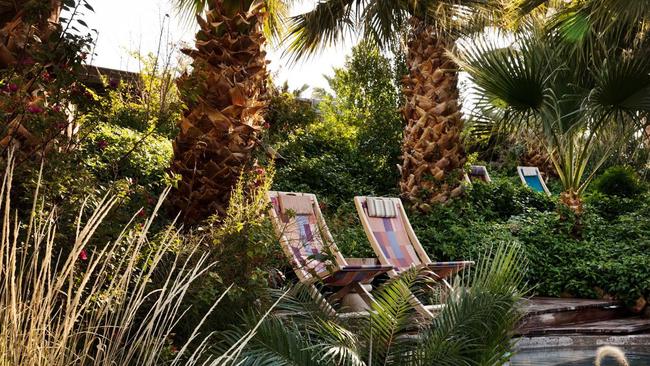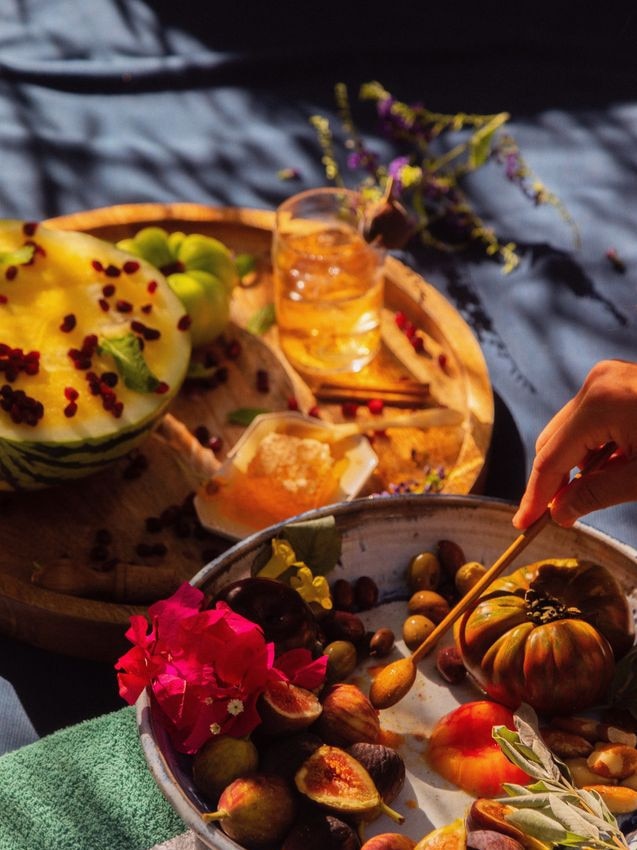The Spa Getaway that’s been a Hollywood hideout since the 1940s
At Desert Hot Springs, a glitz-free escape for Angelenos, the agenda is simple: Sink into a mineral pool, rinse, repeat.

In Robert Altman’s devastating Hollywood satire, The Player, Tim Robbins plays an amoral studio executive pursued by police who suspect him of murder. As cops close in on him at the airport, he hits on an escape plan. “I know this great hideaway in Desert Hot Springs,” he says to his female companion. “It’s a two-hour drive.”
When we next see them, they’re pulling up in a Range Rover to a gated oasis in the desert, dotted with towering palms and stone cottages surrounding a grotto filled with gurgling waters. “It comes right out of the ground,” the Robbins character explains as guests frolic nearby in steaming mineral pools. (Spoiler alert: This romantic idyll is soon interrupted by a phone call from his lawyer.) Seeking an escape of another sort, I set out on the same auto route, with my grown daughter at the wheel, and head for Two Bunch Palms, the sprawling spa resort that Altman had chosen for this shoot. Aside from its brief cameo in the 1992 film, the property has long had a reputation as a refuge, for celebrities seeking privacy and even some real life crooks. Al Capone is rumoured to have holed up at the oasis of Two Bunch Palms during the 1920s.
Desert Hot Springs, which sits on a swath of arid land in the Coachella Valley, styles itself as “spa city” after its most unusual feature: It sits atop two aquifers, one hot and one cold, which supply the mineral waters that flow into the spa resorts and their ubiquitous mineral baths and pools. Those waters are the main draw, whether you’re staying in a posh spa hotel such as Two Bunch Palms, the smaller Hope Springs or even a motel.
While the existence of these warm springs was known to the indigenous Cahuilla tribe for hundreds of years, they weren’t widely reported until the early 20th century. About 1914, a homesteader named Cabot Yerxa, while trying to locate water on his land with his pick and shovel, stumbled on both springs near where Two Bunch stands today. Yerxa named the spot Miracle Hill. Soon after, real estate developers began building a spa centre to rival other mineral spring “cure towns” in the US and abroad.
By the 1940s Desert Hot Springs lured not just Hollywood types but ordinary folks seeking a miracle cure for all manner of ills, from arthritis to polio. Soon there were more than 200 “spa-tels” and bathhouses advertising the therapeutic benefits of their mineral pools. Another selling point was that, unlike the sulfuric waters of warm springs in other places, these desert springs had no rotten egg odour.

Over the years, many of these original resorts fell into disrepair and eventually closed. To be sure, Desert Hot Springs has little in common with its more manicured neighbour to the south, Palm Springs, or the golf-happy Palm Desert. You don’t go there for fancy restaurants or night-life. Rather, it’s the “rebel cousin”, as one denizen put it, of the swankier places nearby. That reputation was further enhanced when the town became a hub for California’s growing cannabis industry (the state legalised the use of marijuana for recreational purposes in late 2016). Visitors to the town quickly notice plenty of signs advertising local weed dispensaries.
Many Desert Hot Springs spas suffered during the pandemic; hot tubs and high touch services such as massages were a hard sell at a time of lockdowns and social distancing. But resorts began fully reopening in the middle of last year, prompting our impromptu getaway.
As soon as we arrive at Two Bunch Palms, extensively renovated in 2018, we notice guests clad in robes wandering around the resort; a few are even dining in the elegant restaurant.
It doesn’t take us long to adjust. Not having to fret about what to wear is another freeing aspect of the spa lifestyle. One repeat guest tells me it reminds her of the ryokan she has stayed at in Japan. It is so quiet we whisper even when we don’t have to. Like most of the boutique hotels and resorts here, Two Bunch Palms is adults only.
Along sandy paths marked with “roadrun- ner crossing” warnings, we drift over to the spaceship-style yoga dome to take a class. After massages in the spa treatment rooms, we order glasses of natural wine on the restaurant patio. Once we’ve shed that nagging feeling we ought to keep busy, we get on the program. Simply put, soak, rinse and repeat. Access to the resort’s pools and most classes are included in the room rate, which starts at about $US400 ($550), but meals and spa treatments are priced separately.
“It’s all about the waters,” says one longtime resident of Desert Hot Springs. And the precious liquid is everywhere. Our suite has its own hot tub in a patio outside the bedroom, but it seems almost redundant given the sheer number of possibilities for solitary soaking. Pools of all different sizes are scattered around the grounds.
I find an unoccupied medium-size pool in a shaded corner off the main path, and am just settling in with a book when an attendant comes by to ask if the temperature is satisfactory, mentioning that most tubs are heated to 38C to 40C. But other than the warmth, what really sets this apart from just sitting in a bubble bath at home? A scientific analysis of the water wasn’t performed until 1937, when, as per local history, “its therapeutic value was affirmed”. In layman’s terms, it contains a mashup of minerals – lithium, silica, magnesium, calcium, among others – that its boosters in the wellness sector claim reduce pain and improve mobility, increase blood circulation and cell oxygenation.
I’m not sure which minerals are at work, but after 48 hours, much of it spent floating in this soothing soup, the persistent soreness in my neck and shoulder have all but vanished. My daughter finds that for pure relaxation, nothing tops a midnight soak under a starry desert sky. Perhaps it’s not a “cure” per se, and to be fair, most of the spas here in Desert Hot Springs aren’t claiming to deliver more than a restful escape. As Two Bunch Palms puts it in its literature, “wellness is whatever you make of it”.

Getting There
Desert Hot Springs is about 110 miles east of Los Angeles, a two-hour drive if you time it right. It’s also 10 miles from Palm Springs International Airport. Other than the middle of summer, when the mercury climbs over 100 degrees Fahrenheit, most seasons are pleasant — winter temperatures hover around 60s and 70s.
Staying There
There are dozens of places, ranging from midcentury budget hotels (some of which do allow children) to fancier spots, some very small. But what they all have in common is their obsession with tapping into those healing warm springs. The following properties are for adult guests (17 or 18 and older):
Two Bunch Palms offers 65 rooms — some are private bungalows, others are in small low-rise buildings — spread out around a 72-acre preserve. They range from newest and least expensive Desert Rooms to the fancy “Al Capone suite,” the oldest dwelling on the site (There’s no evidence the gangster ever slept there). From about $US400 ($570) a night.
The 10-room Hope Springs Resort, an update of a midcentury modern motel, has three pools, hot springs and a range of spa treatments. From about $260 a night. The Spring Resort and Spa has three pools and 13 rooms and suites; it also offers doctor-supervised detoxifying water and juice cleanses. From about $US250 ($350)a night. Recently opened, Azure Palm Hot Springs Resort offers 40 rooms, five pools of varying temperatures and a day spa with a full menu of treatments, including a Himalayan salt scrub. From about $US200 ($270) a night.
Eating There
Non-guests can also reserve a table at Two Bunch Palms’ restaurant; it offers stylish, locally sourced spa cuisine, for both vegans and carnivores (the broiled hanger steak and miso glazed eggplant were our favourites) plus a decent selection of wine and beer. Some smaller hotels don’t have restaurants on the premises, but guests seeking a fine dining experience can head for Palm Springs, a 20-minute drive away.
Exploring There
The Cabot Pueblo Museum showcases Native American art and history in an adobe-style residence built by Cabot Yerxa in 1941. A new hiking trail just opened connecting Desert Hot Springs with Joshua Tree National Park.
The Wall Street Journal

To join the conversation, please log in. Don't have an account? Register
Join the conversation, you are commenting as Logout